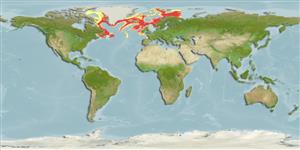分類 / Names
共通名の | 類義語 | Catalog of Fishes(部類, 種) | ITIS | CoL | WoRMS | Cloffa
板鰓亜鋼(サメとエイ類) (sharks and rays) >
Rajiformes (Skates and rays) >
Rajidae (Skates)
Etymology: Rajella: Latin, raja, -ae = a sting ray (Raja sp.) (Ref. 45335); fyllae: Named after Douglas F. Markle who collected and provided the specimens (Ref. 31389).
More on author: Lütken.
Environment: milieu / climate zone / depth range / distribution range
生態学
海 深海魚; 深さの範囲 147 - 2055 m (Ref. 106604), usually 300 - 800 m (Ref. 3167). Deep-water; 1°C - 7°C (Ref. 117245); 84°N - 40°N, 75°W - 55°E (Ref. 114953)
North Atlantic and adjacent fringes of the Arctic Region: offshore of Gulf of Maine and slopes off Newfoundland banks and Labrador to southern Baffin Bay, around southern Greenland to Denmark Strait, south of Iceland, and along Faroe-Shetland ridge to the Skagerrak; west of British Isles from Porcupine Bank and Rockall Plateau to Faroe Islands; and off Norwegian coasts to western Barents Sea and Svalbard.
サイズ / 重さ / 年齢
Maturity: Lm ? range ? - ? cm
Max length : 60.0 cm TL オス/雌雄の選別がない; (Ref. 35388)
簡単な記述
形態学 | 形態計測学
Snout is short and obtuse. Midbelt of its disc and upper surface of its tail are rough with large thorns in irregular rows. Upper surface ash gray to chocolate brown. Lower surface white, grayish white, pale gray or light fawn color, sooty patches on pelvic fins and axils of pectoral fins (Ref. 6902).
Found in deeper shelf and slope waters, in 3-5.5°C water temperature (6902). Benthic (Ref. 58426). Feed on all kinds of bottom animals with preference for invertebrates (Ref. 3167) like copepods, amphipods and mysids (Ref. 6902). Oviparous. Distinct pairing with embrace. Young may tend to follow large objects, such as their mother (Ref. 205). Eggs are oblong capsules with stiff pointed horns at the corners deposited in sandy or muddy flats (Ref. 205). Egg capsules are 3.8-4.2 cm long and 2.4-2.6 cm wide (Ref. 41303, 41251, 41301). It is captured at low level by-catch in bottom-trawl and longline fisheries (Ref. 117245).
Life cycle and mating behavior
成熟 | 繁殖 | 放精 | 卵 | 生産力 | 幼生
Oviparous, paired eggs are laid. Embryos feed solely on yolk (Ref. 50449). Distinct pairing with embrace. Young may tend to follow large objects, such as their mother (Ref. 205).
McEachran, J.D. and K.A. Dunn, 1998. Phylogenetic analysis of skates, a morphologically conservative clade of elasmobranchs (Chondrichthyes: Rajidae). Copeia 1998(2):271-290. (Ref. 27314)
Human uses
水産業: 興味がない
より多くの情報
参考文献水産養殖水産養殖の紹介緊張遺伝子のElectrophoreses遺伝病気行列NutrientsMass conversion
協力者画像Stamps, Coins Misc.音シガテラ(食中毒の名前)速度泳ぐ 型式カマOtoliths脳視覚
用具
特記事項
XMLをダウンロードして下さい
インターネットの情報源
Estimates based on models
Preferred temperature (Ref.
123201): 0.7 - 9.5, mean 3.6 °C (based on 707 cells).
Phylogenetic diversity index (Ref.
82804): PD
50 = 0.5000 [Uniqueness, from 0.5 = low to 2.0 = high].
Bayesian length-weight: a=0.00302 (0.00141 - 0.00645), b=3.24 (3.07 - 3.41), in cm total length, based on LWR estimates for this (Sub)family-body shape (Ref.
93245).
栄養段階 (Ref.
69278): 3.4 ±0.2 se; based on diet studies.
回復力 (Ref.
120179): 低い, 4.5年~14年の倍増期間の最小個体群 (Fec assumed to be <100).
Fishing Vulnerability (Ref.
59153): Moderate vulnerability (44 of 100).
Nutrients (Ref.
124155): Calcium = 5.49 [0.80, 107.06] mg/100g; Iron = 0.328 [0.031, 4.452] mg/100g; Protein = 15.1 [13.0, 17.1] %; Omega3 = 0.494 [0.195, 1.253] g/100g; Selenium = 17.8 [3.1, 85.5] μg/100g; VitaminA = 4.75 [0.34, 63.37] μg/100g; Zinc = 0.305 [0.021, 3.468] mg/100g (wet weight);
